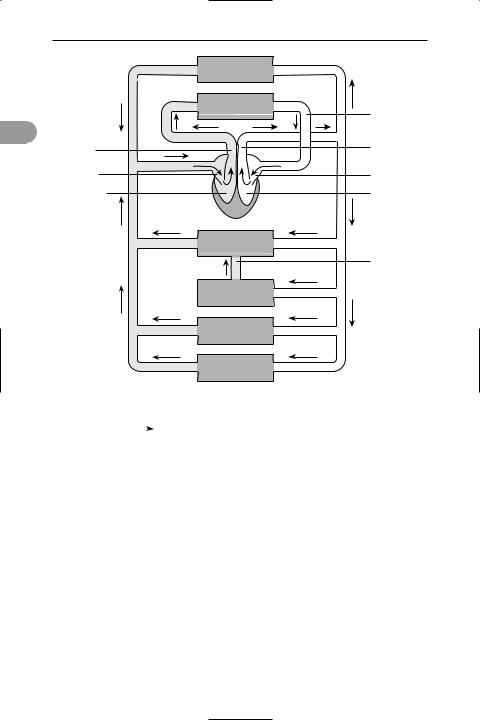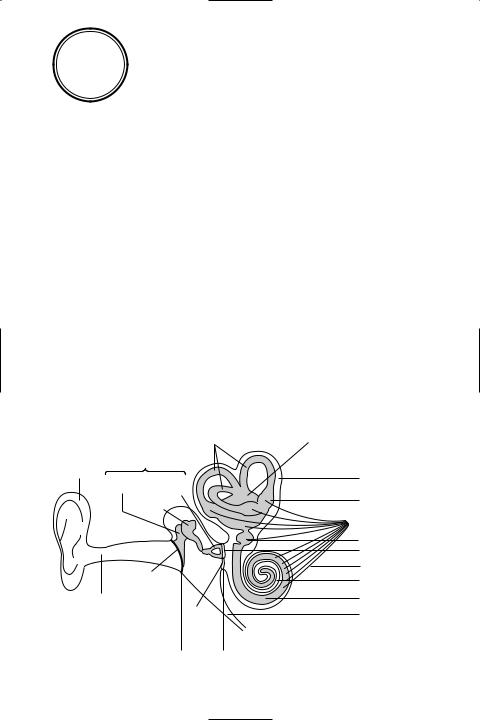
A Dictionary of Science
.pdf
double salt |
|
256 |
|
head |
|
|
lungs |
pulmonary |
|
|
|
d |
|
vein |
|
|
|
pulmonary |
|
aorta |
|
|
|
artery |
|
|
right atrium |
|
left atrium |
right ventricle |
|
left ventricle |
|
heart |
|
|
liver |
|
|
|
hepatic |
|
|
portal vein |
|
gut |
|
kidneys
others parts of body
|
|
|
= oxygenated blood |
|
|
|
|
|
= deoxygenated blood |
|
|
|
|
|
|
||
|
|
|
= direction of blood |
|
|
|
|
|
|||
Double circulation in a mammal |
|
||||
refracting crystal as a birefringent crystal. |
lines in certain spectra, e.g. the two lines |
||||
See also polarization. |
that make up the sodium D-lines. |
||||
double salt A crystalline salt in which |
down feathers (plumules) Small soft |
||||
there are two different anions and/or |
feathers that cover and insulate the whole |
||||
cations. An example is the mineral |
body of a bird. In nestlings they are the |
||||
dolomite, CaCO3.MgCO3, which contains a |
only feathers; in adults they lie between |
||||
regular arrangement of Ca2+ and Mg2+ |
and beneath the *contour feathers. Down |
||||
ions in its crystal lattice. *Alums are dou- |
feathers have a Ûuffy appearance as their |
||||
ble sulphates. Double salts only exist in |
*barbs are not joined together to form a |
||||
the solid; when dissolved they act as a |
smooth vane. |
||||
mixture of the two separate salts. Double |
Downs process A process for extract- |
||||
oxides are similar. |
|||||
ing sodium by the electrolysis of molten |
|||||
doublet 1. A pair of optical lenses of dif- |
|||||
sodium chloride. The Downs cell has a |
|||||
ferent shapes and made of different ma- |
central graphite anode surrounded by a |
||||
terials used together so that the |
cylindrical steel cathode. Chlorine re- |
||||
chromatic aberration produced by one is |
leased is led away through a hood over |
||||
largely cancelled by the reverse aberra- |
the anode. Molten sodium is formed at |
||||
tion of the other. 2. A pair of associated |
the cathode and collected through an- |
||||

257 |
dry cell |
other hood around the top of the cathode cylinder (it is less dense than the sodium chloride). The two hoods and electrodes are separated by a coaxial cylindrical steel gauze. A small amount of calcium chloride is added to the sodium chloride to lower its melting point. The sodium chloride is melted electrically and kept molten by the current through the cell. More sodium chloride is added as the electrolysis proceeds.
Down’s syndrome A congenital form of mental retardation due to a chromosome defect in which there are three copies of chromosome no. 21 instead of the usual two (see trisomy). The affected individual has a short broad face and slanted eyes (as in the Mongolian races), short Üngers, and weak muscles. Down’s syndrome can be detected before birth by *amniocentesis. It is named after the British physician John Down (1828–96), who Ürst studied the incidence of the disorder.
dragonÛies See odonata.
drain See transistor.
dreikanter (German: three edges) A faceted stone or pebble formed in desert regions by erosion by wind-blown sand. The stones are too heavy to be blown along the desert Ûoor and are merely battered back and forth. Most have three curved facets.
drift-tube accelerator See linear accelerator.
drone A fertile male in a colony of social bees, especially the honeybee (Apis mellifera). The drones die after mating with the queen bee as the male reproductive organs explode within the female.
Drosophila A genus of fruit Ûies often used in genetic research because the larvae possess giant chromosomes in their salivary glands. These chromosomes have resulted from repeated duplication without separation of the chromatids; they have conspicuous transverse bands, which can be studied microscopically to reveal gene activity. Fruit Ûies have a short life cycle and produce a large number of offspring, which also makes them a good model animal for genetic research.
drug Any chemical substance that alters the physiological state of a living organism. Drugs are widely used in medicine for the prevention, diagnosis, and treatment of diseases; they include *analgesics, *antibiotics, anaesthetics, *antihistamines, and *anticoagulants.
Some drugs are taken solely for the plea- d surable effects they induce; these include *narcotics; stimulants, such as cocaine
and *amphetamine; *hallucinogens, such as *LSD; and some tranquillizers. Many of these drugs are habit-forming and their use is illegal.
drupe (pyrenocarp) A Ûeshy fruit that develops from either one or several fused carpels and contains one or many seeds. The seeds are enclosed by the hard protective endocarp (see pericarp) of the fruit. Thus the stone of a peach is the endocarp containing the seed. Plums, cherries, coconuts, and almonds are other examples of one-seeded drupes; holly and elder fruits are examples of many-seeded drupes. See also etaerio.
dry cell A primary or secondary cell in which the electrolytes are restrained from Ûowing in some way. Many torch, radio, and calculator batteries are *Leclanché cells in which the electrolyte is an ammonium chloride paste and the container is the negative zinc electrode (with an outer plastic wrapping). Various modiÜcations of the Leclanché cell are used in dry cells. In the zinc chloride cell, the electrolyte is a paste of zinc chloride rather than ammonium chloride. The electrical characteristics are similar to those of the Leclanché cell but the cell works better at low temperatures and has more efÜcient depolarization characteristics. A number of alkaline secondary cells can be designed for use as dry cells. In these, the electrolyte is a liquid (sodium or potassium hydroxide) held in a porous material or in a gel. Alkaline dry cells typically have zinc–manganese dioxide, silver oxide– zinc, nickel–cadmium, or nickel–iron electrode systems (see nickel–iron accumulator). For specialized purposes, dry cells and batteries have been produced with solid electrolytes. These may contain a solid crystalline salt, such as silver iodide, an ion-exchange membrane, or
an organic wax with a small amount of

dry ice |
258 |
dissolved ionic material. Such cells deliver low currents. They are used in miniature cells for use in electronic equipment.
dry ice Solid carbon dioxide used as a refrigerant. It is convenient because it sublimes at –78°C (195 K) at standard
dpressure rather than melting.
drying oil A natural oil, such as linseed oil, that hardens on exposure to the air. Drying oils contain unsaturated fatty acids, such as linoleic and linolenic acids, which polymerize on oxidation. They are used in paints, varnishes, etc.
dry mass The mass of a biological sample after the water content has been removed, usually by placing the sample in an oven. The dry mass is used as a measure of the *biomass of a sample.
Dryopithecus A genus of extinct apes, fossils of which have been found in Europe and Asia and dated to the midMiocene (about 16–7 million years ago). Fossils of Dryopithecus and of the similar genus Proconsul are often referred to as dryopithecines. Dryopithecines are believed to have split into several lines, three of which survived to give rise to the chimpanzees and gorillas, the early hominids, and the orang-utans.
DSC Differential scanning calorimetry.
See thermal analysis.
D-series See absolute configuration.
DTA Differential thermal analysis. See thermal analysis.
dubnium Symbol Db. A radioactive *transactinide element; a.n. 105. It was Ürst reported in 1967 by a group at Dubna near Moscow and was conÜrmed in 1970 at Dubna and at Berkeley, California. It can be made by bombarding californium– 249 nuclei with nitrogen–15 nuclei. Only a few atoms have ever been made.
duct A tube or passage in an organism that is involved in the secretion or excretion of substances (see gland).
ductility The ability of certain metals, such as copper, to retain their strength when their shape is changed, especially the ability of such metals to be drawn into a thin wire without cracking or breaking.
ductless gland See endocrine gland.
ductus arteriosus A channel that connects the pulmonary artery with the aorta in the mammalian fetus and therefore allows blood to bypass the inactive lungs of the fetus. It normally closes soon after birth.
Dulong and Petit’s law For a solid element the product of the relative atomic mass and the speciÜc heat capacity is a constant equal to about 25 J mol–1 K–1. Formulated in these terms in 1819 by the French scientists Pierre Dulong (1785– 1838) and Alexis Petit (1791–1820), the law in modern terms states: the molar heat capacity of a solid element is approximately equal to 3R, where R is the *gas constant. The law is only approximate but applies with fair accuracy at normal temperatures to elements with a simple crystal structure.
Dumas, Jean Baptiste André (1800– 84) French chemist, who became an apothecary in Geneva, where in 1818 he investigated the use of iodine to treat goitre. He then took up chemistry and moved to Paris. In 1826 he devised a method of measuring *vapour density. He went on to discover various organic compounds, including anthracene (1832), urethane (1833), and methanol (1834), which led him in 1840 to propose the theory of types (functional groups).
Dumas’ method 1. A method of Ünding the amount of nitrogen in an organic compound. The sample is weighed, mixed with copper(II) oxide, and heated in a tube. Any nitrogen present in the compound is converted into oxides of nitrogen, which are led over hot copper to reduce them to nitrogen gas. This is collected and the volume measured, from which the mass of nitrogen in a known mass of sample can be found. 2. A method of Ünding the relative molecular masses of volatile liquids by weighing. A thin-glass bulb with a long narrow neck is used. This is weighed full of air at known temperature, then a small amount of sample is introduced and the bulb heated (in a bath) so that the liquid is vaporized and the air is driven out. The tip of the neck is sealed and the bulb cooled and weighed at known (room) temperature. The volume

259 |
DVD |
of the bulb is found by Ülling it with water and weighing again. If the density of air is known, the mass of vapour in a known volume can be calculated.
The techniques are named after J. B. A. Dumas.
dune A mound or ridge of unconsolidated sand formed by the action of wind. Dunes are characteristic of desert regions and some coastlines. Coastal dunes are usually anchored by vegetation, whereas desert dunes generally move gradually in the direction of the prevailing wind. There are various types, often named after their shapes. Crescent-shaped dunes are called barchans, and longitudinal dunes are seif dunes; others include sinuous anklé dunes, star dunes, whaleback dunes and tail dunes, which form in the lee of an obstacle. A large seif dune may be up to 100 m high and 10 km long. Similar structures to dunes may also form underwater by the action of currents.
duodenum The Ürst section of the *small intestine of vertebrates. It is the site where food from the stomach is subjected to the action of bile (from the bile duct) and pancreatic enzymes (from the pancreatic duct) as well as the enzymes secreted by digestive glands in the duodenum itself, which are required in the breakdown of proteins, carbohydrates, and fats. By neutralizing the acidic secretions of the stomach, the duodenum provides an alkaline environment necessary for the action of the intestinal enzymes.
See also intestinal juice.
duplet A pair of electrons in a covalent chemical bond.
duplex Describing a biological molecule comprising two cross-linked polymeric chains oriented lengthways side by side. The term is applied particularly to the double-stranded structure of *DNA.
duplication (in genetics) The doubling or repetition of part of a chromosome, which generally originates during the *crossing over phase of meiosis. Occasionally this type of *chromosome mutation may have beneÜcial effects on a population. For example, a beneÜcial duplication resulted in the evolution of four types of haemoglobin in man and apes from a sin-
gle form. One of these types of haemoglobin (gamma or fetal haemoglobin) has a greater afÜnity for oxygen and maximizes fetal uptake of oxygen from the mother’s blood.
Duralumin Trade name for a class of
|
|
|
strong lightweight aluminium alloys con- |
d |
|
|
|
|
taining copper, magnesium, manganese, |
|
|
|
|
|
and sometimes silicon. Duralumin alloys |
|
|
combine strength with lightness and are |
|
|
extensively used in aircraft, racing cars, |
|
|
etc. |
|
|
dura mater The outermost and tough- |
|
|
est of the three membranes (*meninges) |
|
|
that surround the central nervous system |
|
|
in vertebrates. It lies adjacent to the skull |
|
|
and its purpose is to protect the delicate |
|
|
inner meninges (the *arachnoid mem- |
|
|
brane and the *pia mater). |
|
|
duramen See heartwood. |
|
|
dust core See core. |
|
|
Dutch metal An alloy of copper and |
|
|
zinc, which can be produced in very thin |
|
|
sheets and used as imitation gold leaf. It |
|
|
spontaneously inÛames in chlorine. |
|
|
DVD Digital versatile disk: a disk format |
|
|
similar to a compact disk (see cd-rom) but |
|
|
containing much more data. It was intro- |
|
|
duced in 1996. DVD disks are the same |
|
|
120 mm diameter as CDs with potential |
|
|
capacities of up to 4.7 gigabytes for a sin- |
|
|
gle-sided single-layer disk. The technology |
|
|
involved in DVD storage is similar to that |
|
|
in compact disks, but more precise. The |
|
|
extra capacity is achieved in a number of |
|
|
ways. The tracks on a DVD are closer and |
|
|
the pits are smaller, allowing more pits |
|
|
per unit area. The key to this was the use |
|
|
of a shorter wavelength laser (typically |
|
|
635 or 650 nm in the red region for DVDs |
|
|
as opposed to 780 nm in the infrared for |
|
|
CDs). Moreover, a DVD can have two lay- |
|
|
ers on the same side of the disk. The top |
|
|
layer is translucent and the bottom layer |
|
|
opaque. Data can be read from either |
|
|
layer by refocusing the laser. In addition |
|
|
DVDs may be double-sided. DVD formats |
|
|
also have a more efÜcient error-correction |
|
|
system. The potential capacity of a double- |
|
|
sided double-layer DVD is up to 17 giga- |
|
|
bytes. DVDs have been increasingly used |
|
|
in computing as a higher-capacity version |
|
|
of compact disks. As with compact disks, |
|
|

dwarf star |
260 |
there are various types. DVD-ROM (DVD read-only memory) is similar to CD-ROM. DVD-R (DVD-recordable) is similar to CD-R. There are also different rewritable formats: DVD-RAM, DVD+RW, and DVD-RW.
dwarf star A star, such as the sun, that
dlies on the main sequence in a *Hertzsprung–Russell diagram. See also white dwarf.
dye laser A type of laser in which the active material is a dye dissolved in a suitable solvent (e.g. Rhodanine G in methanol). The dye is excited by an external source. The solvent broadens the states into bands and consequently laser action can be obtained over a range of wave-
lengths. This allows one to select a speciÜc wavelength (using a grating) and to change the wavelength of the laser. Such a device is called a tuneable laser. Dye lasers are also used in producing very short pulses of radiation. The technique is to use a dye that stops absorbing radiation when a high proportion of its molecules become excited. The cavity then becomes resonant and a pulse of radiation is produced. This technique can give pulses of about 10 nanoseconds duration and is used in *femtochemistry.
dyes Substances used to impart colour to textiles, leather, paper, etc. Compounds used for dyeing (dyestuffs) are generally organic compounds containing conjugated double bonds. The group producing
the colour is the *chromophore; other noncoloured groups that inÛuence or
intensify the colour are called *auxochromes. Dyes can be classiÜed according to the chemical structure of the dye molecule. For example, azo dyes contain the
–N=N– group (see azo compounds). In practice, they are classiÜed according to the way in which the dye is applied or is held on the substrate.
Acid dyes are compounds in which the chromophore is part of a negative ion
(usually an organic sulphonate RSO2O–). They can be used for protein Übres (e.g.
wool and silk) and for polyamide and acrylic Übres. Originally, they were applied from an acidic bath. Metallized dyes are forms of acid dyes in which the negative ion contains a chelated metal atom. Basic dyes have chromophores that are
part of a positive ion (usually an amine salt or ionized imino group). They are used for acrylic Übres and also for wool and silk, although they have only moderate fastness with these materials.
Direct dyes are dyes that have a high afÜnity for cotton, rayon, and other cellulose Übres. They are applied directly from a neutral bath containing sodium chloride or sodium sulphate. Like acid dyes, they are usually sulphonic acid salts but are distinguished by their greater substantivity (afÜnity for the substrate), hence the alternative name substantive dyes.
Vat dyes are insoluble substances used for cotton dyeing. They usually contain keto groups, C=O, which are reduced to C–OH groups, rendering the dye soluble (the leuco form of the dye). The dye is applied in this form, then oxidized by air or oxidizing agents to precipitate the pigment in the Übres. Indigo and anthroquinone dyes are examples of vat dyes. Sulphur dyes are dyes applied by this technique using sodium sulphide solution to reduce and dissolve the dye. Sulphur dyes are used for cellulose Übres.
Disperse dyes are insoluble dyes applied in the form of a Üne dispersion in water. They are used for cellulose acetate and other synthetic Übres.
Reactive dyes are compounds that contain groups capable of reacting with the substrate to form covalent bonds. They have high substantivity and are used particularly for cellulose Übres.
dyke A sheetlike vertical *intrusion of igneous rock cutting across the strata of older rocks. Dykes vary in thickness from a few centimetres to several metres. Several dykes may be grouped, radially or in parallel, as a dyke swarm. Depending on composition and how long it took to cool, a dyke’s grain structure may be coarse, medium, or Üne.
dynamical meteorology The branch of meteorology concerned with motions in the atmosphere. It is based on hydrodynamics and thermodynamics.
dynamic equilibrium See equilibrium.
dynamics The branch of mechanics concerned with the motion of bodies under the action of forces. Time intervals, distances, and masses are regarded as funda-

261 |
dystrophic |
mental and bodies are assumed to possess *inertia. Bodies in motion have an attribute called *momentum (see newton’s laws of motion), which can only be changed by the application of a force.
Compare kinetics; statics.
dynamite Any of a class of high explosives based on nitroglycerin. The original form, invented in 1867 by Alfred Nobel, consisted of nitroglycerin absorbed in kieselguhr. Modern dynamites, which are used for blasting, contain sodium or ammonium nitrate sensitized with nitroglycerin and use other absorbers (e.g. wood pulp).
dynamo An electric *generator, especially one designed to provide *direct current. Alternating-current generators can be called dynamos but are more often called alternators.
dynamo action The generation of electrical current and magnetic Üeld by the motion of an electrically conducting Ûuid. It is generally believed that the magnetic Üelds of the earth and the sun are produced by dynamo action in the molten iron–nickel core of the earth and in the plasma of the solar interior.
dynamometer 1. An instrument used to measure a force, often a spring balance. 2. A device used to measure the output
power of an engine or motor. 3. (current dynamometer) A variety of *current balance, for measuring electric current.
dyne The unit of force in the *c.g.s. system; the force required to give a mass of one gram an acceleration of 1 cm s–2.
|
|
|
1 dyne = 10–5 newton. |
d |
|
|
|
|
dysprosium Symbol Dy. A soft silvery |
|
|
metallic element belonging to the *lan- |
|
|
thanoids; a.n. 66; r.a.m. 162.50; r.d. 8.551 |
|
|
(20°C); m.p. 1412°C; b.p. 2562°C. It occurs |
|
|
in apatite, gadolinite, and xenotime, from |
|
|
which it is extracted by an ion-exchange |
|
|
process. There are seven natural isotopes |
|
|
and twelve artiÜcial isotopes have been |
|
|
identiÜed. It Ünds limited use in some al- |
|
|
loys as a neutron absorber, particularly in |
|
|
nuclear technology. It was discovered by |
|
|
Paul Lecoq de Boisbaudran (1838–1912) in |
|
|
1886. |
|
|
dystectic mixture A mixture of sub- |
|
|
stances that has a constant maximum |
|
|
melting point. |
|
|
dystrophic Describing a body of water, |
|
|
such as a lake, that contains large |
|
|
amounts of undecomposed organic matter |
|
|
derived from terrestrial plants. Dystrophic |
|
|
lakes are poor in dissolved nutrients and |
|
|
therefore unproductive; they are common |
|
|
in peat areas and may develop into peat |
|
|
bogs. |
|
|

E
e The irrational number deÜned as the limit as n tends to inÜnity of (1 + 1/n)n. It has the value 2.718 28…. It is used as the base of natural *logarithms and occurs in the *exponential function, ex.
ear The sense organ in vertebrates that is specialized for the detection of sound and the maintenance of balance. It can be divided into the *outer ear and *middle ear, which collect and transmit sound waves, and the *inner ear, which contains the organs of balance and (except in Üsh) hearing (see illustration).
eardrum See tympanum.
early universe The study of *cosmology at the time very soon after the *big bang. Theories of the early universe have led to a mutually beneÜcial interaction between cosmology and the theory of *elementary particles, particularly *grand uniÜed theories.
Because there were very high temperatures in the early universe many of the
*broken symmetries in *gauge theories become unbroken symmetries. As the universe cools after the big bang there is thought to be a sequence of transitions to broken symmetry states.
Combining cosmology with grand uniÜed theories helps to explain why the observed universe appears to consist of matter with no antimatter. This means that one has a nonzero *baryon number for the universe. This solution relies on the fact that there were nonequilibrium conditions in the early universe due to its rapid expansion after the big bang.
An important idea in the theory of the early universe is that of inÛation – the idea that the nature of the *vacuum state gave rise, after the big bang, to an exponential expansion of the universe. The hypothesis of the inÛationary universe solves several long-standing problems in cosmology, such as the Ûatness and homogeneity of the universe. Quantum Ûuctuations during inÛation have been suggested as a mechanism for the forma-
|
semicircular |
utriculus |
|
|
canals |
||
ear ossicles |
|
||
pinna |
stapes |
perilymph |
|
malleus |
|
||
(hammer) |
(stirrup) |
|
|
incus |
ampulla |
||
(anvil) |
|
||
|
|
auditory nerve |
|
|
|
sacculus |
|
|
|
oval window |
|
|
|
nerve fibre |
|
tympanum |
cochlea |
||
(eardrum) |
|||
|
|||
external |
|
endolymph |
|
auditory meatus |
round |
Eustachian tube |
|
|
window |
||
|
|
||
outer ear |
middle |
inner ear |
|
ear |
|||
Structure of the mammalian ear

263 |
earth’s atmosphere |
tion of large-scale structures. Evidence for this theory has been provided by *COBE and by *WMAP.
ear ossicles Three small bones – the incus (anvil), malleus (hammer), and stapes
(stirrup) – that lie in the mammalian *middle ear, forming a bridge between the tympanum (eardrum) and the *oval window. The function of the ossicles is to transmit (and amplify) vibrations of the tympanum across the middle ear to the oval window, which transfers them to the *inner ear. Muscles of the middle ear constrict the movement of the ossicles. This serves to safeguard the ear from damage caused by excessively loud noise.
earth The planet that orbits the sun between the planets Venus and Mars at a mean distance from the sun of
149 600 000 km. It has a mass of about 5.974 × 1024 kg and an equatorial diameter of 12 756.3 km. The earth consists of three layers: the gaseous atmosphere (see earth’s atmosphere), the liquid *hydrosphere, and the solid *lithosphere. The solid part of the earth also consists of three layers: the crust with a mean thickness of about 32 km under the land and 10 km under the seas; the mantle, which extends some 2900 km below the crust; and the core, part of which is believed to be liquid. The crust has a relative density of about 3 and consists largely of sedimentary rocks overlaying igneous rocks. The composition of the crust is: oxygen 47%, silicon 28%, aluminium 8%, iron 4.5%, calcium 3.5%, sodium and potassium 2.5% each, and magnesium 2.2%. Hydrogen, carbon, phosphorus, and sulphur are all present to an extent of less than 1%. The mantle reaches a relative density of about 5.5 at its maximum depth and is believed to consist mainly of silicate rocks. The core is believed to have a maximum relative density of 13 and a maximum temperature of 6400 K. See also geomagnetism; plate tectonics.
earthquake A sudden movement or fracturing within the earth’s lithosphere, causing a series of shocks. This may range from a mild tremor to a large-scale earth movement causing extensive damage over a wide area. The point at which the earthquake originates is known as the seismic
focus; the point on the earth’s surface directly above this is the epicentre (or hypocentre). See seismic waves. Earthquakes result from a build-up of stresses within the rocks until they are strained to the point beyond which they will fracture. They occur in narrow continuous belts of activity, which correspond with the junction of lithospheric plates, including the
circum-PaciÜc belt, the Alpine–Himalayan e belt, and mid-ocean ridges. The scale of
the shock of an earthquake is known as the magnitude; the most commonly used scale for comparing the magnitude of earthquakes is the logarithmic *Richter scale (9.5 is the highest recorded magnitude on the scale).
earth’s atmosphere The gas that surrounds the earth. The composition of dry air at sea level is: nitrogen 78.08%, oxygen 20.95%, argon 0.93%, carbon dioxide 0.03%, neon 0.0018%, helium 0.0005%, krypton 0.0001%, and xenon 0.00001%. In addition to water vapour, air in some localities contains sulphur compounds, hydrogen peroxide, hydrocarbons, and dust particles.
The lowest level of the atmosphere, in which most of the weather occurs, is called the troposphere. Its thickness varies from about 7 km at the poles to 28 km at the equator and in this layer temperature falls with increasing height. The next layer is the stratosphere, which goes up to about 50 km. Here the temperature remains approximately constant. Above this is the ionosphere, which ex-
tends to about 1000 km, with the temperature rising and the composition changing substantially. At about 100 km and above most of the oxygen has dissociated into atoms; at above 150 km the percentage of nitrogen has dropped to nil. In the ionosphere the gases are ionized by the absorption of solar radiation. This enables radio transmissions to be made round the curved surface of the earth as the ionized gas acts as a reÛector for certain wavelengths. The ionosphere is divided into three layers. The D-layer (50–90 km) contains a low concentration of free electrons and reÛects lowfrequency radio waves. The E-layer (90–150 km) is also called the Heaviside layer or Heaviside–Kennelly layer as its ex-

earth sciences |
264 |
e
km
550 |
|
|
|
|
|
|
500 |
exosphere |
|
|
|
|
|
450 |
|
|
|
|
|
|
400 |
|
|
|
|
|
|
|
|
|
|
|
|
|
350 |
|
F region |
|
|
|
|
300 |
|
|
|
|
|
|
250 |
|
(Appleton |
|
|
|
|
|
ionosphere |
layer) |
|
|
|
|
|
|
|
(Heaviside–Kennelly |
|||
200 |
|
|
|
|||
|
|
|
layer) |
|
|
|
150 |
|
|
|
|
|
|
|
E region |
|
|
|
|
|
|
|
|
|
|
|
|
100 |
|
|
|
|
|
|
|
D region |
|
|
|
|
|
|
|
|
|
|
|
|
50 |
|
|
|
|
|
|
stratosphere |
|
|
|
|
||
|
|
|
|
|
||
0 |
troposphere |
|
|
|
|
|
|
0 |
–2 –4 |
|
–6 – 8 –10 –12 –14 |
||
|
|
|
||||
|
|
|
|
log |
10 |
density (kg m–3) |
Earth’s atmosphere
istence was predicted independently by Oliver Heaviside (1850–1925) and Arthur E. Kennelly (1861–1939). This layer reÛects medium-frequency waves. The F-layer (150–1000 km) is also called the Appleton layer after its discoverer Sir Edward Appleton (1892–1965). It has the highest concentration of free electrons and is the most useful for radio transmission. Wavelengths between 8 mm and 20 m are not reÛected by the ionosphere but escape into space. Therefore television transmissions, which utilize this range, require artiÜcial *satellites for reÛection (or reception, ampliÜcation, and retransmission). From about 400 km, the outermost region of the atmosphere is also called the exosphere. See illustration.
earth sciences A group of sciences concerned with the study of the earth. The chief earth sciences are geology, physical geography, oceanography, meteorology, geophysics, and geochemistry.
earthshine Sunlight reÛected from the surface of the earth. An observer in space may see nearby objects dimly illuminated
by earthshine, as things on earth may be illuminated by moonlight. Under certain conditions near new moon the dark disc of the moon can be seen faintly illuminated by earthshine – a phenomenon called ‘the old moon in the new moon’s arms’.
earthslide The movement of a layer of dry soil down a slope. The soil layer is inherently unstable and shears, sometimes brought about by the action of water. But if the soil becomes very wet, and the slope is steep, an earthÛow may occur. Contributory factors are sparse vegetation and sudden rainfall.
earth’s magnetic Üeld See geomag-
netism.
earwigs See dermaptera.
ebonite See vulcanite.
ebullioscopic constant See elevation of boiling point.
ebullioscopy The use of *elevation of boiling point to determine relative molecular masses.

265 |
ecliptic |
eccentricity See conic.
Eccles, Sir John Carew (1903–97) Australian physiologist, who was educated in Melbourne and Oxford, and held appointments in Britain, Australia, New Zealand and, Ünally, the USA. While in Australia he carried out his best-known work, on the transmission of nerve impulses across synapses, which he attributed to the neurotransmitter acetylcholine. He shared the 1963 Nobel Prize for physiology or medicine with Sir Alan Hodgkin (1914–98) and Sir Andrew Huxley (1917– ), who worked in the same area of biology.
ecdysis (moulting) 1. The periodic loss of the outer cuticle of arthropods. It starts with the reabsorption of some materials in the inner part of the old cuticle and the formation of a new soft cuticle. The remains of the old cuticle then split; the animal emerges and absorbs water or swallows air and increases in size while the new cuticle is still soft. This cuticle is then hardened with chitin and lime salts. In insects and crustaceans ecdysis is controlled by the hormone *ecdysone. 2. The periodic shedding of the outer layer of the epidermis of reptiles (except crocodiles) to allow growth to occur.
ecdysone A steroid hormone, produced by insects and crustaceans, that stimulates moulting (see ecdysis) and metamorphosis. It acts on speciÜc gene loci, stimulating the synthesis of proteins involved in these bodily changes.
ECG See electrocardiogram.
echelon A form of *interferometer consisting of a stack of glass plates arranged stepwise with a constant offset. It gives a high resolution and is used in spectroscopy to study hyperÜne line structure. In the transmission echelon the plates are made equal in optical thickness to introduce a constant delay between adjacent parts of the wavefront. The reÛecting echelon has the exposed steps metallized and acts like an exaggerated *diffraction grating.
Echinodermata A phylum of marine invertebrates that includes the sea urchins, starÜsh, brittlestars, and sea cucumbers. Echinoderms have an exoskeleton (test) of calcareous plates embedded
in the skin. In many species (e.g. sea |
|
|
|
urchins) spines protrude from the test. A |
|
|
|
system of water-Ülled canals (the water |
|
|
|
vascular system) provides hydraulic power |
|
|
|
for thousands of tube feet: saclike pro- |
|
|
|
trusions of the body wall used for loco- |
|
|
|
motion, feeding, and respiration. |
|
|
|
Echinoderms have a long history: fossils |
|
|
|
of primitive echinoderms are known from |
|
|
|
e |
|
||
rocks over 500 million years old. |
|
|
|
echo The reÛection of a wave by a sur- |
|
|
|
face or object so that a weaker version of |
|
|
|
it is detected shortly after the original. |
|
|
|
The delay between the two is an indica- |
|
|
|
tion of the distance of the reÛecting sur- |
|
|
|
face. An echo sounder is an apparatus for |
|
|
|
determining the depth of water under a |
|
|
|
ship. The ship sends out a sound wave |
|
|
|
and measures the time taken for the echo |
|
|
|
to return after reÛection by the sea bot- |
|
|
|
tom. Sonar (sound navigation ranging) is a |
|
|
|
technique for locating underwater objects |
|
|
|
by a similar method. Echoes also occur |
|
|
|
with radio waves; reÛection of waves |
|
|
|
causes an echo in radio transmission and |
|
|
|
ghosts in television pictures. See also |
|
|
|
radar. |
|
|
|
echolocation 1. See radar; echo. |
2. A |
|
|
method used by some animals (such as bats, dolphins, and certain birds) to detect objects in the dark. The animal emits a series of high-pitched sounds that echo back from the object and are detected by the ear or some other sensory receptor. From the direction of the echo and from the time between emission and reception of the sounds the object is located, often very accurately.
ECL See emitter-coupled logic.
eclipse The total (total eclipse) or partial (partial eclipse) obscuring of light from a celestial body as it passes behind or through the shadow of another body. A lunar eclipse occurs when the sun, earth, and moon are in a straight line and the shadow of the earth falls on the moon. A solar eclipse occurs when the shadow of the moon falls on the earth. See illustrations.
eclipsed conformation See conformation.
ecliptic The *great circle in which the plane of the earth’s orbit round the sun
